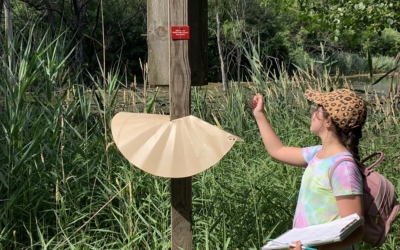Constellation | Exceeding Requirements to Keep Bats Safe and Undisturbed
At first glance, the Indiana bat might evoke a different creature entirely — this mammal’s small ears are not unlike those of a rodent, which explains why the first part of its scientific name translates to “mouse ears.” While the species was first sighted in a cave in Indiana, these bats are found throughout the eastern and midwestern United States, but unfortunately, have been listed as federally endangered since the 1960s due to habitat loss and human disturbances. Energy supplier Constellation’s Criterion Wind bat project is working to address both of these concerns.
Operated by Criterion Power Partners (CPP) and located in Oakland, Maryland, Criterion Wind houses 28 wind turbines across 117 acres. Beginning in 2015, CPP entered into a conservation agreement with the Mountaineer Chapter of the Izaak Walton League of America, a national conservation organization, to go above and beyond required efforts to mitigate wind farm impacts on bat populations.
CPP consulted with Bat Conservation International, who determined that the Izaak Walton Cave in Randolph County, West Virginia, would be a suitable location to protect Indiana bats as well as little brown bats, northern long-eared bats and more. A social species, Indiana bats hibernate through the winter in large colonies, requiring specific cave conditions like low, stable temperatures and an absence of drafts. These specific needs, along with shrinking natural habitats due to development, leave them with relatively few options; in 2019, a majority of the Indiana bat population hibernated in four sites across three states.
In addition to the lack of available habitat, human disturbances also have a detrimental impact on bats. Izaak Walton Cave is a well-known area that was previously easy for people to access, but when humans enter a bat hibernaculum, the noises and disturbances create the risk of bats abandoning the location entirely. With this information in mind, CPP developed a solution that allows bats to freely access the cave while restricting human entry: bat gates.
These metal structures were installed at several cave entrances to minimize unauthorized human entry to the caves, serving the added benefits of reducing the human-facilitated introduction of white-nose syndrome (WNS). This disease, caused by a fungus that grows on bats’ noses, impacts bats around the world by triggering them to wake up during hibernation, use up their fat reserves and ultimately starve. As there is currently no cure for WNS, prevention is the best course of action, so part of CPP’s monitoring efforts at the cave include looking for indications of WNS such as fungus on the cave’s surfaces or any abnormal bat behavior.
The cave is adjacent to the Monongahela National Forest, an ecosystem that also plays a large role in bat lifecycles. “A land use management plan protects the forest habitat for foraging, roosting, swarming and breeding cycles for multiple bat species, many of which are currently listed as endangered,” explained Kelly Stein, Sr. Environmental Program Manager – Natural Resources with Constellation. This forest management plan includes annual plant surveys to document the species present, ensuring that there is high-quality, native vegetation to support bats’ foraging and roosting needs when they are not hibernating.
For Criterion Wind, mitigation regulations were a starting point for an impactful project. These efforts go above and beyond the requirements in several ways: by focusing on measures that impact the greater population of Indiana bats and including other bat species in their efforts. “Although your conservation project may be initiated through a regulatory obligation for mitigation,” said Stein, “it can exceed requirements and result in a high-value benefit for a species.” For Stein, the most rewarding aspects of this project have been the opportunity for Constellation to align its efforts with those of organizations like the Izaak Walton League, the West Virginia Division of Natural Resources and the US Fish and Wildlife Service to contribute to the recovery of endangered bat species.
Related Content:
Blogs:
Webinars:
-
- Picturing a Better World for Bats: Stories from a Conservation Photographer
- Books, Bats and Breaking Stigmas: Inspiring Bat Conservation Through Literature
- Creating Bat-Friendly Gardens and Urban Habitats to Help Prevent Bat Extinction
- Underground Wonders: The Importance of Caves and Karst in Bat Conservation
- Bat Conservation on Your Corporate Landscape
- Why Bats Matter: Protection and Awareness Strategies
Project Guidances:
White Papers:
Quick Facts
| Site Name: | Criterion Wind |
|---|---|
| Category: | Member Spotlight |
| Site Location: | Oakland, Maryland |
| Partners: | Izaak Walton League, Kleinschmidt, U.S. Fish and Wildlife Service, West Virginia Division of Natural Resources, Western Ecosystems Technologies (WEST) |
| Project Types: | Bats, Caves & Subterranean, Forests, Species of Concern |
| Certification Level: | Gold Certified |
| WHC Index Link: | Learn more about this program |


